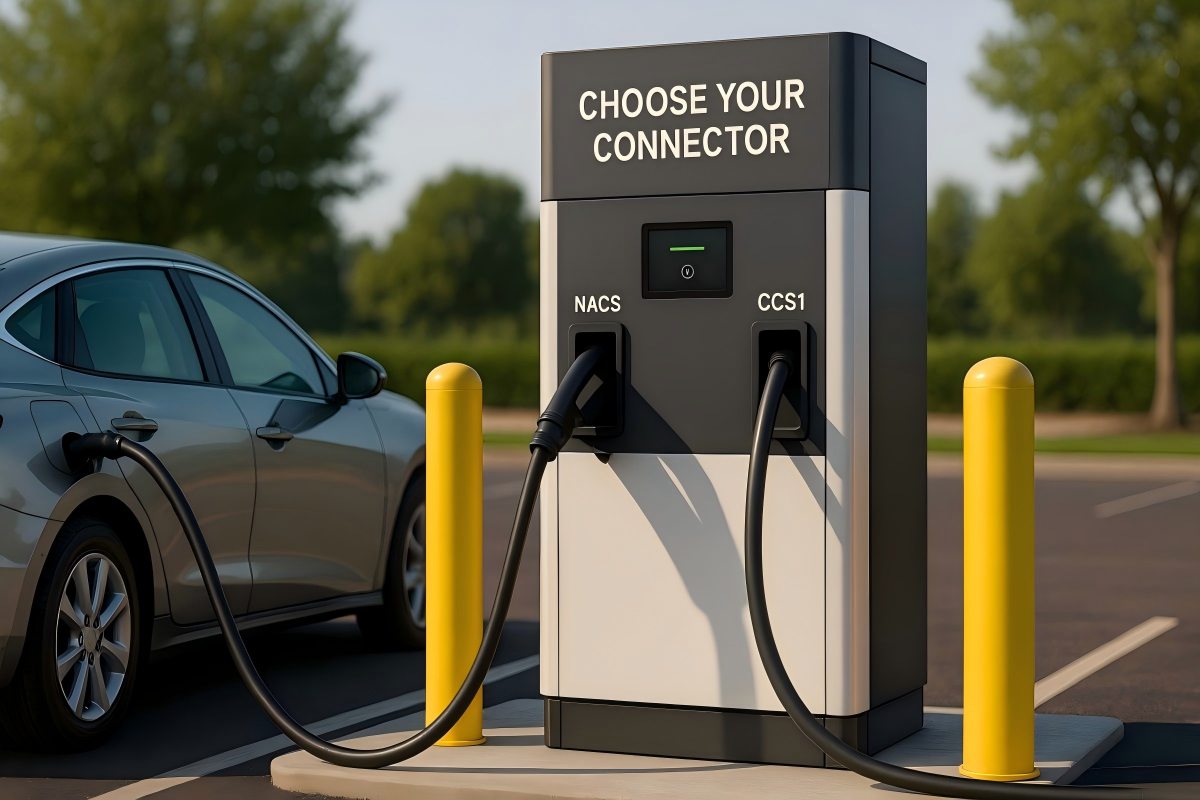
When a mainstream cabinet like Wayne PWR adds a NACS cable option, it’s not just another spec update. It signals a shift from “adapter workarounds” to native, side-by-side support for NACS and CCS1 at the site level. That changes design choices, queue logic, cable management—and ultimately the driver’s first 30 seconds at the charger.
Dover Fueling Solutions has enabled NACS cable configurations on its Wayne PWR DC fast chargers. The platform already spans multiple power tiers (commonly 160–640 kW in the current lineup), and now site hosts can deploy CCS1, NACS, or a mix across units. In plain terms: forecourts can meet Tesla/NACS demand without relying on adapters, and they can scale NACS share over time as traffic data justifies it.

1) Queueing and bay assignment become real product decisions.
Mixed connectors at one site sound simple—until a busy hour exposes bottlenecks. If two adjacent dispensers each carry different leads (say one NACS and one CCS1), your on-screen routing, app copy, and ground signage decide whether drivers self-sort or gridlock. A practical pattern we see working: dedicate some cabinets to dual-lead (NACS + CCS1) where dwell is high, and keep single-lead cabinets for throughput lanes. Make the choice predictable from the drive-in sightline (pylon, bay markers, screen headers).
2) Power-sharing strategies need a rewrite.
Cabinets with shared rectification will juggle different vehicles and charge curves. A NACS EV arriving hot from the highway may immediately request high current; a CCS1 EV on a cold pack will ramp slower. Your algorithm should prefer pairing complementary curves on the same cabinet to reduce throttling. Even a small improvement in pairing logic shows up as fewer complaints and more kWh sold per hour.
3) Cable management and thermal behavior are now day-one priorities.
As currents rise, cable weight, bend radius, and return path become failure vectors. Avoid floor drags and tight S-curves; design a clean return-to-hook path that a first-time driver can follow without thinking. For most mixed sites, starting with air-cooled NACS leads at ~200–250 A is a rational baseline. Plan structural allowance—boom arms, hanger geometry, or side-exit guides—so you can upgrade to liquid-cooled assemblies on the busiest bays without reworking the pedestal or plinth.
4) Retrofit math looks better than many expect.
For brownfield stations that already run CCS1, adding NACS is often a cable/lead-side change plus UI updates, not a total cabinet swap. That keeps capex and downtime predictable. The catch: don’t underinvest in UX signals—screen labels, bay signage, and app flows. Most “reliability” complaints in mixed sites trace back to ambiguous instructions, not electronics.
5) Maintenance SOPs should call out connector-specific checks.
Do nightly sweeps for twists, kinks, and incomplete re-hangs. Add quick-glance checks for latch wear, debris in inlet areas, and any hot-spot patterns on high-use bays. Instrument your helpdesk scripts so agents ask the right first two questions for NACS vs CCS1 sessions; fast triage cuts truck rolls.
Phase 1 — Instrument & signal (Weeks 0–3)
Pick two bays to carry dual leads (NACS + CCS1).
Update UI copy: before-plug screen shows “Choose the connector that matches your vehicle: NACS or CCS1.”
Add wayfinding: pavement icons and head-height markers that drivers can see from 15–20 m.
Phase 2 — Tune the pairing logic (Weeks 3–6)
Use session data to identify curve conflicts (e.g., two hot packs starving a third).
Adjust cabinet pairing: high-ramp NACS with medium-draw CCS1 where possible.
Track % sessions ≥90 kW within 60 s as a leading indicator of perceived performance.
Phase 3 — Decide where liquid-cooled pays (Weeks 6–12)
If two NACS bays exceed 30% of site kWh and average cable temp margins narrow at peak, justify liquid-cooled on those bays.
Keep one adjacent bay on air-cooled for redundancy and to cover shoulder periods economically.
Left/right lead planning: align the default return path with the majority vehicle inlet position for your mix, so drivers aren’t twisting cables across the chassis.
No-drag discipline: if the hook design still causes belly-drag, add a mid-span guide rather than asking drivers to “be careful”—human factors always win.
One-screen, no jargon: on screen, avoid “J3400/NACS” or “SAE this/that.” Use NACS and CCS1 terms with simple icons.
Tighten the first 30 seconds: tap-to-pay acceptance, connector latch feel, and immediate current ramp set the memory of “this site works.”
EV connector engineering support: connector choice, current targets, and thermal headroom for your vehicle mix.
High-current cable routing: hanger geometry, bend-radius checks, and return-to-hook paths that lower strain and trip risks.
Liquid-cooled EV cable solutions: phased upgrades on the busiest bays without altering your pedestal footprint.
Standards aren’t about picking a side; they’re about meeting your traffic with the least friction. Wayne PWR’s native NACS option makes the dual-standard era tangible, and the winners will be the sites that fix the boring details—queue logic, cable paths, and first-tap flow—before the crowds arrive.